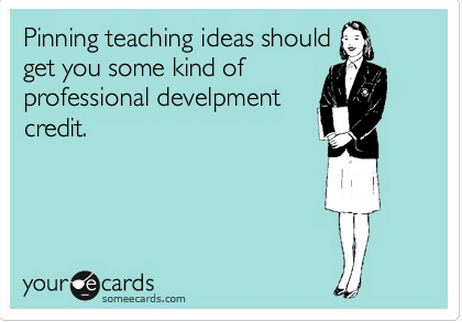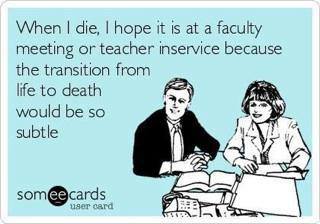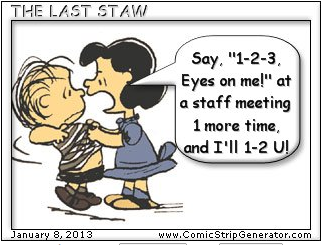Most of us will have to take part in professional development sessions either this summer or the week before school starts, and let’s be honest, much of it won’t be very interesting. I’ve been thinking a lot lately about how teachers can get more out of these mandatory inservices, and I’ve realized there are a few choices participants can make that will determine whether the training is at least moderately valuable or a complete waste of time. The tips that follow are things I’ve observed teachers doing (and have done myself) that resulted in PD being only slightly less painful that stabbing yourself in the eye with a fork. Try them out at your own risk.

Give your administrators full control over your professional learning.
Refuse to implement any new technology or teaching strategies until you’ve received more boring PD on it. Make it your mantra that you will only learn what you’re told to learn. Let your principal decide what is important for you to be an expert in, and only attend trainings on those topics. After all, building your own professional learning network (PLN) and reading books and blog posts on professional topics you care about gives you ownership of your learning and empowers you as an educator. Is that what you really want?

Immediately point out all the reasons why a new idea won’t work.
I’ve totally been guilty of this. In fact, I thought I doing the group a favor by saying what everyone else was thinking but was afraid to speak out loud. Now, I realize I was just derailing the learning of the entire group by forcing them to think about the limitations before they’d fully considered the possibilities. I’ve found that I learn a lot more when I just listen, reflect on all the options as they’re presented, and then brainstorm with the group or a colleague at the end of the session.
Focus on the three kids in your class for whom the new ideas will be completely ineffective.
It’s tempting to block out the fact that the majority of your class could really benefit from the strategy, and spend the entire PD session fuming about how useless it is because little Johnny will never go for it. But let’s face it: there will always be at least three kids in your class with whom ANY teaching strategy will crash and burn. There are no teaching strategies that work 100% of the time with 100% of students, so it makes more sense to listen to the PD session with a full range of kids in mind.

Hold side conversations the whole time.
This is a fantastic way to ruin a training, because talking will ensure that the PD becomes useless for your colleagues, as well. Bonus points for holding side conversations about how the ideas you’re hearing will never, ever work with your students. However, even on-topic side conversations will be enough to distract everyone around you and throw your presenter slightly off of his or her game. There’s nothing more awkward than one adult trying to get the attention of other adults in a professional setting, so chattering endlessly is a great way to make your presenter resort to annoying kindergarten-style attention grabbers which you can also complain about.

Jot down notes on a piece of paper and stick it in your file cabinet, never to be seen again.
If you do manage to learn something in the PD session, be sure to keep it to yourself! If you blog about it, share it on social media, or talk with your colleagues about their thoughts, you’re likely to encourage them to try new things and improve their teaching. Sharing your learning also gives you the opportunity to reflect on what you heard and figure out how to apply it to your classroom practice. So, if you want to make sure the principles you learned never have an impact on students, bury those notes in a folder! Sharing and collaborating will only lead to more learning.
What’s your advice for teachers on how to get more (or less!) out of the professional development they attend? Please share your thoughts in the comments.

Angela Watson
Founder and Writer
Discussion
Leave a Reply
OR

Join our
community
of educators
If you are a teacher who is interested in contributing to the Truth for Teachers website, please click here for more information.
















Angela-
Great point, and that’s HILARIOUS!!!! What irony- I never thought of that before! LOL!!!
Heidi
My previous admins would let me knit (hats in circular needles so I knit without looking) under the table and take copious notes at the same time…I showed then that the knitting helped me stay focused on whoever was presenting…they were pleased when I showed them my detailed notes…my professor at grad school let me do the same thing…
My new school, however, is all about project-based learning and collaboration so I never had a chance to itch for my needles in the 2 weeks (yes, 2 weeks) of PD before school started and I hope this year will be similar but even better!
Two weeks of high quality PD?! Wow! That’s awesome.
This is great! It describes most of our meetings. I find it is so easy to get sucked into the negative talk about PDs not being useful. I am most guilty about complaining when it is the PDs that are specific to grade levels but do not benefit the others at all. We have had trainings on various topics with K through 12th grade teachers all together. The presenters would even make comments about how difficult it is to present to such a wide range! I agree that admin needs to differentiate when possible so that it is not a waste of time. However, I also agree that in many of the meetings we can usually find at least 1 thing that applies to us and will help us to be better teachers. I may have to file this in the “read often” file : )
Yes, yes, YES, to everything you said about differentiating PD! I prefer to work with one grade level at a time so the group is small and intimate and I can make sure I’m sharing examples that will work with that particular group of teachers. Sometimes that’s not possible, but it’s definitely something principals should consider.
Great piece Angela. We will definitely share it with our networks. Our PL participants will find it very amusing as we often make fun of traditional professional learning approaches and why they disengage the learner. PL needs to be useful and relevant and allow people engage in the learning but the learner also needs to ensure they take responsibility for trying to engage! Unfortunately what makes your post even funnier is that there is a lot of irrelevant and useless PL that staff are forced to engage in which doesn’t help!
Thank you, Dave! I’ve written a lot about bad PD, but you’re right that participants have the choice of whether to engage or not. I still have to attend unhelpful PD myself even as an instructional coach, and I try to keep in mind that I am responsible for my own learning–for me, that’s an empowering thought.
Are you sure you weren’t sitting in one of my PD meetings? I make myself sit up front so I will stay focused. I agree, also, that I have learned to listen before deciding that I have to speak for the grade level or the group I am sitting with. Teachers are the WORST for side conversations, but my principal had finally taken a stand…if she hears talking and she is the speaker, she stops until the side talkers get the message. If someone else is presenting, my principal calls them out…”Ms. Smith, do you have a comment you would like to share?”. I also agree with Dave Faulkner that the PD must be relevant and usable for the classroom teacher.
LOL, Susan! Teachers are definitely the worst for side conversations. I am pretty much incapable of not talking while others are presenting, it’s a horrible habit! I can control myself if I’m allowed to tweet or participate in a backchannel, though.
I like that your principal calls people out. I have done that myself and I find it’s the most effective way to stop side chatter and bring everyone back to one conversation. I pause, smile, and say in a warm, friendly tone, “Did you want to add something to that?” Almost every time, the teacher then shares an example from his or her own classroom or asks a question. I love it.
Most of the PD I present is technology based. These provides lots of time to check email. So I like to present project based. I let “advanced” students play and work ahead but as I walk around I stop and have them share ideas and show them tricks they may not know but would be too advanced for some others. What is hard for me is when I’m asked to fit my presentation into “20min next Thursday before the students arrive”.
I have met people who take offense at side conversations but I am one of those people who has a terrible time focusing without multitasking (eating right now). So I totally do the change to turn and talk while I focus on someone who is really paying attention and then ask for sharing. Sometimes this time to talk helps everyone refocus.
I like the option of online PD. I participated in one where the instructors did a lot of talking and then asked us to type in ideas. This was great for me – I even went and was cooking dinner while processing and had a lot to type in on topic. Other people can’t focus without face to face. Its great when a variety of options are available.
Loved the humor in your article.